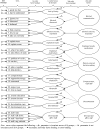Interpersonal processes of care survey: patient-reported measures for diverse groups
- PMID: 17489912
- PMCID: PMC1955252
- DOI: 10.1111/j.1475-6773.2006.00637.x
Interpersonal processes of care survey: patient-reported measures for diverse groups
Abstract
Objective: To create a patient-reported, multidimensional physician/patient interpersonal processes of care (IPC) instrument appropriate for patients from diverse racial/ethnic groups that allows reliable, valid, and unbiased comparisons across these groups. DATA SOURCE/DATA COLLECTION: Data were collected by telephone interview. The survey was administered in English and Spanish to adult general medicine patients, stratified by race/ethnicity and language (African Americans, English-speaking Latinos, Spanish-speaking Latinos, non-Latino whites) (N=1,664).
Study design/methods: In this cross-sectional study, items were designed to be appropriate for diverse ethnic groups based on focus groups, our prior framework, literature, and cognitive interviews. Multitrait scaling and confirmatory factor analysis were used to examine measurement invariance; we identified scales that allowed meaningful quantitative comparisons across four race/ethnic/language groups.
Principal findings: The final instrument assesses several subdomains of communication, patient-centered decision making, and interpersonal style. It includes 29 items representing 12 first-order and seven second-order factors with equivalent meaning (metric invariance) across groups; 18 items (seven factors) allowed unbiased mean comparison across groups (scalar invariance). Final scales exhibited moderate to high reliability.
Conclusions: The IPC survey can be used to describe disparities in interpersonal care, predict patient outcomes, and examine outcomes of quality improvement efforts to reduce health care disparities.
Figures
References
-
- Agency for Healthcare Research and Quality. National Healthcare Disparities Report. Rockville, MD: 2003. [Accessed on April 1, 2005]. Available at http://www.qualitytools.ahrq.gov/disparitiesreport/download_report.aspx.
-
- Agency for Healthcare Research and Quality. 2004 National Healthcare Disparities Report (No. 05–0014) Rockville, MD: U.S. Department of Health and Human Services; 2004.
-
- Beach MC, Cooper LA, Robinson KA, Price EG, Gary TL, Jenckes MW, Gozu A, Smarth C, Palacio A, Feuerstein CJ, Bass EB, Powe NR. Strategies for Improving Minority Healthcare Quality: Evidence Report/Technology Assessment No. 90 (No. 04-E008-02) Rockville, MD: Agency for Healthcare Research and Quality; 2004. - PMC - PubMed
-
- Bentler PM. Comparative Fit Indexes in Structural Models. Psychological Bulletin. 1990;107(2):238–46. - PubMed
-
- Bethell C, Carter K, Lansky D, Latzke B, Gowen K. Measuring and Interpreting Health Care Quality across Culturally-Diverse Populations: A Focus on Consumer-Reported Indicators of Health Care Quality. New York: 2003. Foundation for Accountability. [Accessed on April 30, 2005]. Available at http://www.markle.org/resources/faact/index.php.


